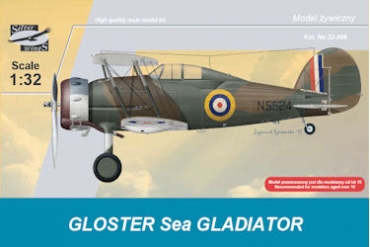Gloster Sea Gladiator
-
 Box
Box
-
 Mk II N 5519"G6A" - 802 Squadron, HMS Glorius, 1939
Mk II N 5519"G6A" - 802 Squadron, HMS Glorius, 1939
-
 N 5519 "R" - Gladiator Flight Hal Far, Malta, June 1940
N 5519 "R" - Gladiator Flight Hal Far, Malta, June 1940
-
 N 5524, No 261 Squadron, Luqa, Malta, January 1941
N 5524, No 261 Squadron, Luqa, Malta, January 1941
History
The Gladiator was to be the last British biplane fighter and the first fighter with an enclosed cockpit. The design was being eclipsed by new generation (monoplane) fighters, such as the RAF’s new Hawker Hurricane and Supermarine Spitfire. A modified Mk II, the Sea Gladiator, was developed for the Royal Navy’s Fleet Air Arm (FAA), with an arrestor hook to be engaged when landing on an aircraft carrier, catapult points, a strengthened frame and an under-belly fairing for a dinghy lifeboat. Of the 98 aircraft built as, or converted to Sea Gladiators, 54 were still in service by the outbreak of the Second World War in September 1939. One of the best-known campaigns where Gladiators were used was the Siege of Malta in 1940. The fighter force defending Malta was, for a period of ten days, a small force of British-operated Gladiators, the Hal Far Fighter Flight, giving rise to a myth the aircrafts’ names ‘’Faith’’, ‘’Hope’’ and ‘’Charity’’, formed the entire fighter cover of the island. The aircraft names came into being only after the battle was over. A total of 747 aircraft were built ,483 of which for the Royal Air Force, 98 for the Royal Navy; and the rest was exported to 14 countries (Belgium, China, Egypt, Finland, Free France, Greece, Iraq, Ireland, Latvia, Lithuania, Norway, Portugal, South Africa, Sweden) .
Technical data:
Length: 8,36 m
Wingspan: 9,83 m
Height: 3,58 m
Wing area: 30,00 m²
Empty weight: 1462 kg
Loaded weight: 2088 kg
Power plant: Bristol Mercury IX, 619 kW (830 hp)
Max speed: 407 km/h
Endurance: 2 hours
Service ceiling: 10000 m
Armament: four machine guns








































